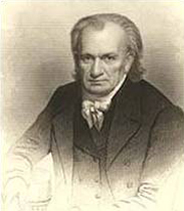1776 – 1842

Amos Eaton was born May 17, 1776 in Chatham, New York. At the age of 16, he wrote a book on surveying. He graduated from Williams College in 1799. He later studied law in New York City and was admitted to the state bar in 1802. From 1802 to 1810 he practiced law and worked as a land agent and surveyor in Catskill, New York. In 1811 he was imprisoned on charges of forgery in a land dispute.
Although Eaton and many others always maintained his innocence, he spent nearly five years in jail. During his incarceration, he began a course of scientific studies. Upon his release, he spent a year at Yale College studying science under Benjamin Silliman and Eli Ives. He then returned to Williams College where he introduced a very successful course of scientific lectures and published A Botanical Dictionary and Manual of Botany for the Northern States in 1817. In 1818 Eaton moved to the Troy-Albany area and spent the next six years as an itinerant lecturer in New York and Vermont compiling textbooks in chemistry, zoology, and geology. DeWitt Clinton arranged for him to deliver a series of lectures to the New York State Legislature on the state's geology in connection with building of the Erie Canal. Among the legislators who heard these lectures was Stephen Van Rensselaer.
Under Van Rensselaer's patronage he undertook geological and agricultural surveys of Albany and Rensselaer counties and across New York State along the route of the Erie Canal . His published survey reports earned him national recognition in the field of American geology in the 1820's. In 1824 Eaton wrote a letter to Van Rensselaer asking for his support for an experimental school. Van Rensselaer decided to finance the school as his previous experience had given him confidence in Eaton's "brain and industry." It would be called the Rensselaer School. Van Rensselaer was the ninth Patroon of Rensselaerwyck, which consisted of large parts of Rensselaer, Albany, and Columbia counties in New York State. The school was founded to teach the application of science to the common purposes of life and was housed in North Troy in Eaton's home. Van Rensselaer took care of the official duties of the school, and Eaton took care of everything else, including all modifications necessary to convert his home into a school.
Eaton's philosophy of education was different from anyone before him, as he believed the lecture method was not conducive to learning. There was no reason, he insisted, why interest could not be "successfully excited " in "every department of human learning " and was convinced that a college founded on his principles would succeed. Eaton's philosophy of education was radically different from most of his colleagues in that he believed in learning by doing, not learning by telling. His five rules of education, which he developed in the early years of the College, are still valid today. They were: 1. Let the student make practical applications of all the sciences, with the immediate direction and showing of the teacher, before studying any elementary rules; 2. Let the student always take the place of the teacher in his exercises. He must make every subject his own and then teach his fellows and the school-master, as though there were not a book in the world which treated on this subject, and he was the very oracle of science; 3. Let a student attend to but one branch of learning at the same time. Personal exercise in the afternoon, at surveying, engineering, collecting plants and minerals, inspecting factories, machines, and agricultural operations, may be permitted; For, although reflection is required, such exercises call such different faculties into action, that the mind is not thereby burdened or fatigued; 4. Let all the amusements and the recreation of students be of a scientific character. Collecting and preserving minerals and plants, surveying, and engineering, are good amusement; and 5. Let every student daily criticize those whose exercise he has attended. Such as to point out all errors in language, etc... . No exercise sharpens the faculty of discrimination like this while it causes each student to be perpetually on his guard.
From 1824 until his death in 1842, Eaton ran the Rensselaer School, later the Rensselaer Institute, in accordance with these five rules. He was an early proponent of women's education and collaborated with Emma Willard and occasionally taught natural science to her students at the Troy Female Seminary. He attempted to introduce a Ladies Course at Rensselaer in the 1830s, but his efforts were rejected by the school's Board of Examiners. Typically, a student would only spend one year at the school to obtain his degree. In 1834, civil engineering was added to the curriculum for the first time, and in 1835 six students graduated with the first civil engineering degrees awarded in the world. Eaton previously taught surveying and natural philosophy. It was a small, but major, step to start teaching engineering. For the rest of the century, the school graduated mainly civil engineers. It changed its name to the Rensselaer Institute and later to Rensselaer Polytechnic Institute and expanded its curriculum to first three years and later four years. He died May 10, 1842, three years after his colleague Stephen Van Rensselaer.
He is buried in Oakwood Avenue Cemetery in Troy, NY. As a man "His person was quite striking, - a large frame, somewhat portly and dignified, though entirely free of what is commonly called starch. His face was highly intellectual, - the forehead high and somewhat retreating, locality strongly marked, and the organs of observation and comparison well developed."

